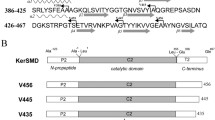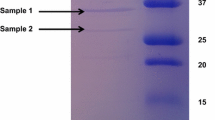Abstract
In silico analysis of keratinase Ker P from Pseudomonas aeruginosa revealed that its full gene of 1,497 bp constituted of a 72-bp signal sequence along with a long 520 bp pro-sequence and 905 bp core region. Position specific multiple sequence alignment of Ker P protein with other distant proteases revealed high variability within their N-terminal regions while the core protein was considerably conserved. Ker P (F1) and its four N-terminal truncations (F2-F5) lacking 72, 177, 405, 507 bp, respectively, were cloned and constitutively expressed as extracellular protein in pEZZ-18 secretory vector with Escherichia coli HB101 as the expression host. Ker P F1, Ker P F2, Ker P F3 and Ker P F4 products were active whereas no keratinolytic activity was obtained in Ker P F5. Further analysis revealed that only 187 bp pro-sequence region is required for correct folding of the protein into its active conformation and, thus, has chaperone-like activity. Further, comparative biochemical characterization revealed that the full-length keratinase Ker P F1 was catalytically more efficient than the truncated forms. Among the truncated enzymes, keratinase Ker P F4 exhibited better thermostability than Ker P F2 with a t1/2 of >1 h at 60 °C. It also had a higher V max and K m on casein as compared with Ker P F2. However, no significant variation was observed with respect to kinetics on synthetic substrates.





Similar content being viewed by others
References
Demidyuk, I. V., Shubin, A. V., Gasanov, E. V., & Kostrov, S. V. (2010). Biomolecular Concepts, 1, 305–322.
Eder, J., & Fersht, A. R. (1995). Molecular Microbiology, 42, 609–614.
Sidhu, S. S., & Borgford, T. J. (1996). Journal of Molecular Biology, 257, 233–245.
Sharma, R., & Gupta, R. (2010). Research in Microbiology, 5(10), 954–965.
Bendtsen, J. D., Nielsen, H., Heijne, G., & Brunak, S. (2004). Journal of Molecular Biology, 340, 783–795.
Altschul, S. F., Wootton, J. C., Gertz, E. M., Agarwala, R., Morgulis, A., Schäffer, A. A., et al. (2005). FEBS Journal, 272, 5101–5109.
Altschul, S. F., Madden, T. L., Schäffer, A. A., Zhang, J., Zhang, Z., Miller, W., et al. (1997). Nucleic Acids Research, 25, 3389–3402.
Simossis, V. A., Kleinjung, J., & Heringa, J. (2005). Nucleic Acids Research, 33(3), 816–824.
Sharma, R., & Gupta, R. (2010). Biotechnology Letters, 32(12), 1863–1868.
Dozie, I. N. S., Okeko, C. N., & Unaeze, N. C. (1994). World Journal of Microbiology and Biotechnology, 10, 563–567.
Serkina, A. V., Shevelev, A. B., & Chestukhina, G. G. (2001). Bioorganicheskaia Khimiia, 27, 323–346.
Tiwary, E., & Gupta, R. (2010). Journal of Agricultural and Food Chemistry, 58(14), 8380–8385.
Mclver, K. S., Kessler, E., & Ohman, D. E. (2004). Microbiology, 150, 3969–3977.
Acknowledgments
R. Sharma acknowledges the University Grants Commission for providing her with Senior Research Fellowship and N. Apurva Ratan Murty acknowledges the Council for Scientific and Industrial Research for providing him with the Junior Research Fellowship.
Author information
Authors and Affiliations
Corresponding author
Rights and permissions
About this article
Cite this article
Sharma, R., Murty, N.A.R. & Gupta, R. Molecular Characterization of N-Terminal Pro-sequence of Keratinase Ker P from Pseudomonas aeruginosa: Identification of Region with Chaperone Activity. Appl Biochem Biotechnol 165, 892–901 (2011). https://doi.org/10.1007/s12010-011-9306-z
Received:
Accepted:
Published:
Issue Date:
DOI: https://doi.org/10.1007/s12010-011-9306-z




